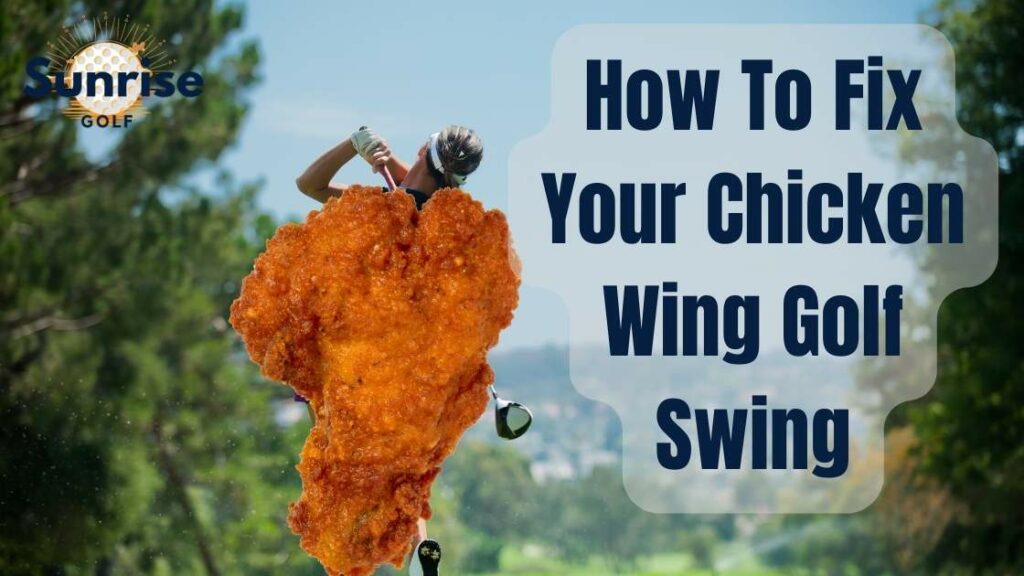Are you tired of struggling with your golf swing? Well, listen up, because we’ve got a game-changing solution for you. Imagine a swing that feels as smooth as butter, effortlessly propelling that little white ball down the fairway.
Say goodbye to the dreaded chicken wing golf swing, my friend. In this article, we’ll dive deep into the causes, impact, and most importantly, the techniques to correct this pesky swing flaw.
Get ready to unleash your true potential on the golf course.
Understanding the Chicken Wing Golf Swing
You’ll need to grasp the concept of the chicken wing golf swing to improve your game. There are common misconceptions about this technique, but understanding it can greatly benefit your performance on the course.
One of the most common misconceptions about the chicken wing golf swing is that it’s a flaw or mistake. However, this couldn’t be further from the truth. The chicken wing refers to the position of the lead arm during the follow-through, where it bends and tucks close to the body. Many golfers mistakenly believe that a straight lead arm is the ideal position, but the chicken wing can actually provide several benefits.
The chicken wing allows for a more natural and powerful release of the clubhead through impact. By allowing the lead arm to bend, you create a whip-like effect that generates more clubhead speed and distance. Additionally, the chicken wing promotes a more consistent swing path, reducing the chances of slicing or hooking the ball.
Common Causes of the Chicken Wing
If you’re struggling with a chicken wing in your golf swing, there are several common causes that may be contributing to this issue. Understanding these common mistakes can help you identify the root cause of your chicken wing and work towards correcting it.
One of the main causes of a chicken wing is poor chicken wing golf swing mechanics. This occurs when your lead arm bends too much during the downswing, creating a chicken wing-like shape. This can happen due to a lack of extension in the lead arm or improper sequencing of the body and arms during the swing.
Another common mistake that leads to a chicken wing is a lack of rotation in the upper body. When you fail to rotate your upper body fully through the swing, it can cause your lead arm to collapse and result in a chicken wing. Additionally, a weak grip can also contribute to a chicken wing. If your grip is too weak, it can lead to a breakdown in the lead arm and cause a chicken wing to occur.
To correct these common mistakes and eliminate the chicken wing from your golf swing, it’s essential to focus on improving your chicken wing golf swing mechanics. This includes working on your arm extension, sequencing, and upper body rotation. Additionally, developing a stronger grip can help prevent the collapse of the lead arm and promote a more efficient swing.
The Impact of the Chicken Wing on Your Game
Experiencing a chicken wing in your golf swing can significantly hinder your game. The chicken wing refers to a faulty swing motion where the lead arm (left arm for right-handed golfers) bends excessively during impact, resembling the shape of a chicken wing. This swing flaw affects clubhead speed and has a psychological impact on a golfer’s confidence.
The chicken wing restricts the extension of the lead arm, leading to a loss of clubhead speed. When the lead arm bends, it prevents the club from fully accelerating through impact, resulting in a weaker and shorter shot. The lack of clubhead speed reduces the distance the ball travels, making it harder to reach the desired target. Additionally, the chicken wing can cause inconsistent contact with the ball, leading to off-center hits and a loss of accuracy.
Beyond its physical implications, the chicken wing can also have a negative psychological impact on a golfer’s confidence. Golf is a mental game, and any swing flaw can create doubt and frustration. When a golfer consistently sees the chicken wing in their swing, it can erode their belief in their abilities and lead to self-doubt. This lack of confidence can further compound the issue, making it even more challenging to correct the swing flaw.
Correcting the Chicken Wing: Tips and Techniques
To fix the chicken wing in your golf swing, focus on proper arm extension and rotation through impact. Correcting this common mistake requires improving flexibility and making a few adjustments to your technique. Here are some tips and techniques to help you straighten out your swing and achieve better results on the golf course:
- Strengthen your core: A strong core is essential for maintaining balance and stability throughout your swing. Incorporate exercises such as planks, Russian twists, and medicine ball rotations into your fitness routine to improve your core strength.
- Stretch your shoulders and chest: Tightness in the shoulders and chest can contribute to a chicken wing. Perform stretches such as shoulder rolls, doorway stretches, and chest openers to increase flexibility in these areas.
- Engage your triceps: The triceps play a crucial role in achieving proper arm extension. Incorporate exercises such as tricep dips, overhead tricep extensions, and push-ups into your workout routine to strengthen and activate your triceps.
- Focus on wrist hinge: Proper wrist hinge allows for a better release through impact. Practice drills that help you maintain a solid wrist position such as the towel drill or using a training aid designed to promote proper wrist hinge.
- Seek professional guidance: A golf instructor can provide valuable insights and personalized guidance to help you correct your chicken wing. They can analyze your swing and provide specific drills and exercises tailored to your needs.
Drills to Eliminate the Chicken Wing
You can use these drills to help eliminate the chicken wing in your golf swing. The chicken wing is a common problem among golfers where the lead arm bends at impact, causing a loss of power and accuracy. By focusing on improving your swing mechanics, you can correct this issue and experience a more fluid and powerful swing.
One drill that can help you correct the chicken wing is the towel drill. Simply fold a towel and place it under your lead arm, between your bicep and chest. As you swing, focus on keeping the towel pressed against your chest throughout the entire swing. This will train your muscles to maintain the correct arm position and prevent the chicken wing from occurring.
Another helpful drill is the one-arm drill. Take your lead hand off the club and practice swinging with only your trail arm. This drill will help you develop better extension and rotation through impact, eliminating the chicken wing motion.
Lastly, the mirror drill can be highly beneficial in correcting the chicken wing. Set up in front of a mirror and take slow practice swings, paying close attention to your arm position. Aim to keep your lead arm straight and extended through impact, ensuring a proper release of the club.
Conclusion
In conclusion, the chicken wing golf swing can greatly affect your game and hinder your performance on the course. By understanding the common causes of the chicken wing and implementing the correct techniques and drills, you can eliminate this flaw and improve your swing.
Just like a bird spreading its wings and soaring through the sky, mastering the proper golf swing will allow you to soar to new heights in your game.
So embrace the challenge, practice diligently, and watch your game take flight.

